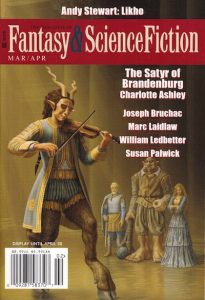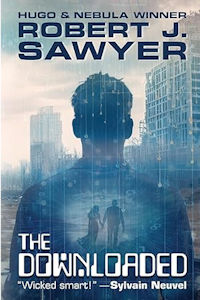Rich Horton Reviews Short Fiction: F&SF, Analog, and Asimov’s
 F&SF 3-4/18
F&SF 3-4/18
Analog 3-4/18
Asimov’s 3-4/18
Let’s begin with the March-April issues of the three leading digests. F&SF continues its strong recent run, with a March-April issue full of enjoyable work. Susan Palwick’s “Hideous Flowerpots” is a heart-warming story about a woman running a successful art gallery who isn’t happy, as evidenced by, among other things, her harsh reaction to people bringing her substandard art, and how another woman stages an intervention, with the help of a magical measuring tape (the only fantastical element in the story, and a rather slim one). There’s some button pushing here, but the story is well told and I enjoyed it. Charlotte Ashley continues her series about La Héron, a magical swordswoman at the turn of the 18th Century, and her somewhat unwanted sidekick, Sister Louise-Alexandrine (Alex). In “The Satyr of Brandenburg”, La Héron is participating in an Exhibition at the somewhat shady Marquess of Solemnis’s seat, and her main concern is that the Satyr, another participant, will cheat, which might affect not just her and her fellow fighters but Alex. It’s more good fun, and I look forward to further entries in this series.
Joseph Bruchac, a celebrated Abenaki writer, makes his first appearance in F&SF with “The Next to the Last of the Mohegans”, a very enjoyable mix of Native American wisdom and SF – as our narrator Billy’s best friend, the mad Mohegan scientist Arlin Sweetwater, decides to use a time machine to outwit the local Little People – but that never goes well for humans, and Billy has to do some careful negotiation to save Arlin’s bacon. Bruchac’s storyteller voice is the highlight here. Three further short stories display three separate modes of horror, all effectively. William Ledbetter’s “The Beast From Below” is comic SF horror, set in the ‘50s, as a mutated armadillo menaces a Texas town, leaving it up the sheriff and the lady mayor, to whom he is unaccountably attractive, to solve the problem. While that was fun, the other two pieces are a lot darker, but still effective. Marc Laidlaw’s “A Swim and a Crawl” is about a man who has decided to swim out to sea off Hawaii to commit suicide, and who then decides not to, and makes it back to a curiously changed shore; it’s good existential, meditative, horror (if that’s what it should be called). And G.V. Anderson’s “Down Where Sound Comes Blunt” is set in a future where an intelligent aquatic species, called variously mermaids or selkies, has been discovered. Ellen Riba’s father was convinced of their existence before it was confirmed, and became an expert, but he’s disappeared. Ellen, who can speak the language, is trying to find him, in the sea near Greenland. Her obsession leads her to a dangerous dive, and a truly scary final revelation.
Analog has also been on a hot streak lately, and this issue is no exception. The lead novelette, “The Spires” by Alec Nevala-Lee, offers an interesting explanation to an old Fortean mystery, the appearance in the Alaskan sky of images of a distant city, and wraps a strong character-based adventure around it. Bill Lawson is a bush pilot in 1930s Alaska, hired by a couple to fly them up to Glacier Bay. They are trying to study the phenomenon of the city images, and that’s where one old prospector claimed to have seen them. He takes them there (illegally), and then a storm damages the plane. He finds himself battling not just nature and the problem of fixing his aircraft, but his own dark temptations, and his skepticism about the couple’s beliefs. The mystery stays mostly a mystery, with hints of a plausible and SFnal explanation. Suzanne Palmer’s “The Streaming Man” is built around a clever premise: Rohn has developed a way to let one’s body give real-time feedback from various internal sensors in the form of music, and he’s been streaming his feedback, which has unexpectedly become a hit on the web. Perhaps too much of a hit. There are trolls and fanatics, even an attack on him. And how might this affect his hope for a relationship with a woman he meets? This is fine, small-scale SF, interesting if not mind-blowing, with a nice character story embedded. Brian Trent’s “An Incident on Ishtar” concerns Melissa, a non-neurotypical woman who has moved to the clouds of Venus (a recently very fashionable setting), partly to escape her issues dealing with people, and partly because of a terrible mistake she made. Now there has been a bad storm, and one of the Demes (the aerostats in which people live in the clouds) is lost, feared crashed. Melissa has a plan, though – because she thinks she has made another terrible mistake, and because she knows the missing Deme has not crashed. Her solution to the problem is a nice bit of speculative engineering, and the backstory (of little interest to Melissa but a lot to us and to her fellow colonists) is an interesting political mess. This is a good example of the best sort of traditional Analog story.
In Asimov’s, I was most impressed with a few of the shorter stories. “Love Songs for the Very Awful” by Robert Reed examines some of the ways a technology to map and even alter someone’s personality could play out, looking at the researcher who did the original work, and one of her subjects, a young man who seems borderline sociopathic. The speculation is intriguing, the characters interesting, and the resolution is slick and ironic. Rich Larson’s “In Event of Moon Disaster” is fine work about a two-person team investigating a mysterious crevasse on the Moon, when all of a sudden a second copy of one the team members appears – followed by a third, and so on. There are obvious existential questions here (and echoes of course of Rogue Moon!), but also practical questions, as their shuttle can only take so many people. Best of all, I think, is Alexandra Renwick’s “Because Reasons”, an impassioned message from one teenaged friend staying home to their now “unfriend,” who is leaving for Mars – giving us a believable and moving picture of a friendship and of the age-old stresses on friendship refracted through future issues.
Recommended Stories
“Down Where Sound Goes Blunt”, G.V. Anderson (F&SF 3-4/18)
“The Next to Last of the Mohegans”, Joseph Bruchac (F&SF 3-4/18)
“The Spires”, Alec Nevala-Lee (Analog 3-4/18)
“Love Songs for the Very Awful”, Robert Reed (Asimov’s 3-4/18)
“Because Reasons”, Alexandra Renwick (Asimov’s 3-4/18)
“An Incident on Ishtar”, Brian Trent (Analog 3-4/18)
Rich Horton works for a major aerospace company in St. Louis MO. He has published over a dozen anthologies, including the yearly series The Year’s Best Science Fiction and Fantasy from Prime Books, and he is the Reprint Editor for Lightspeed Magazine. He contributes articles and reviews on SF and SF history to numerous publications.
This review and more like it in the May 2018 issue of Locus.
 While you are here, please take a moment to support Locus with a one-time or recurring donation. We rely on reader donations to keep the magazine and site going, and would like to keep the site paywall free, but WE NEED YOUR FINANCIAL SUPPORT to continue quality coverage of the science fiction and fantasy field.
While you are here, please take a moment to support Locus with a one-time or recurring donation. We rely on reader donations to keep the magazine and site going, and would like to keep the site paywall free, but WE NEED YOUR FINANCIAL SUPPORT to continue quality coverage of the science fiction and fantasy field.






